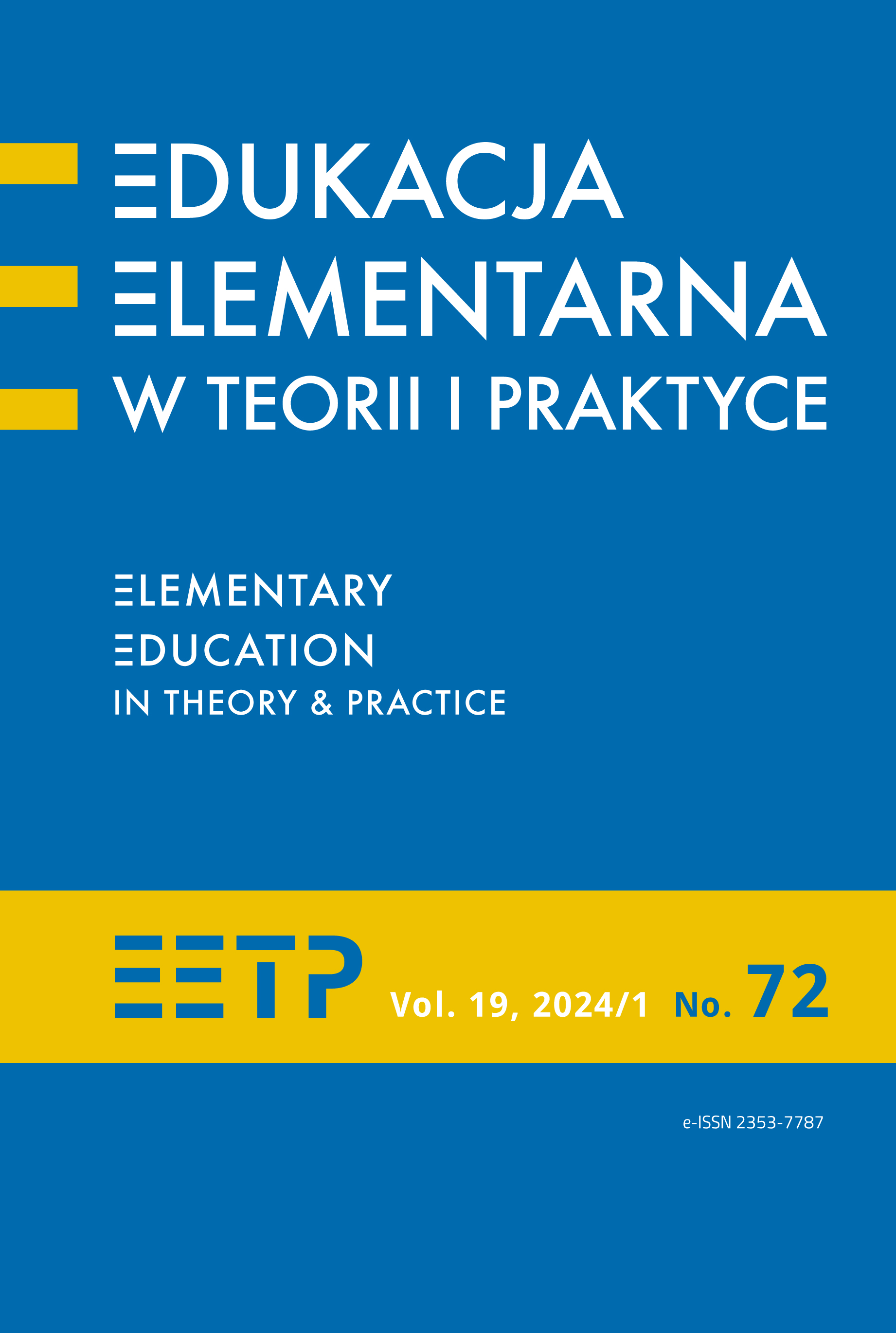Językowy obraz jednostek miar w studenckich bajkach matematycznych
Abstrakt
W artykule analizujemy zadania tekstowe pochodzące z bajek matematycznych, napisanych w latach 2020–2022 przez studentów Uniwersytetu Śląskiego w Katowicach. Celem analizy jest wyłonienie pojęć matematycznych i jednostek miary oraz opis rozwiązań metodycznych adekwatnych dla uczniów klas 1–3. Uwzględniamy ustalenia dydaktyki i metodologii matematycznej, kognitywistyczną teorię analizy tekstu, neurodydaktyczne wskazówki dotyczące kształcenia matematycznego oraz wymagania formalne dla absolwentów pierwszego etapu edukacji. Oryginalny materiał badawczy pochodzi z zadań tekstowych zawartych w 98 bajkach matematycznych. W analizie stosujemy podział zadań tekstowych ze względu na obecność w nich konwencjonalnych i niekonwencjonalnych jednostek miary. Prezentujemy te typy zadań metrologicznych, które zyskały największą frekwencję w materiale badawczym. W zadaniach tekstowych konwencjonalne jednostki miary są stosowane w sposób przemyślany i intencjonalny. Obecność niekonwencjonalnych jednostek miary należy wiązać m.in. z antropocentrycznym postrzeganiem świata. Uważamy, że bajki stanowią atrakcyjny kontekst procesu uczenia się dzieci w wieku wczesnoszkolnym. Antologia bajek matematycznych wraz z sugestiami metodycznymi mogłaby stanowić alternatywę dla szkolnych zadań tekstowych.
Bibliografia
Adamczyk, M. (2019). Jak dziecko uczy się języka? [Wideo]. YouTube. https://youtu.be/7c5b8xfM75o
Bednarek, A. (1994). Leksykalne wykładniki parametryzacji świata. Studium semantyczne. Wydawnictwo UMK.
Bortliczek, M. i Raszka, R. (2022). Dziecięca matematyka w przestrzeni baśniowej – studenckie kreacje narracyjne. Horyzonty Wychowania, 21(59), 57–67. https://doi.org/10.35765/hw.2022.2159.07
Gruszczyk-Kolczyńska, E. (2014). Czas: dni i noce, pory roku, dni w tygodniu, miesiące w roku. Obliczenia kalendarzowe i zegarowe. W: E. Gruszczyk-Kolczyńska (red.), Edukacja matematyczna w klasie I. Książka dla nauczycieli i rodziców. Cele i treści kształcenia, podstawy psychologiczne i pedagogiczne oraz opisy zajęć z dziećmi (s. 189–202). CEBP.
Jakubiec, W. i Malinowski, J. (2004). Metrologia wielkości geometrycznych. Wydawnictwa Naukowo-Techniczne.
Kosek, A. i Kowalska, M. (2018). Storyline — metoda wyzwalająca aktywność poznawczą dzieci w wieku przedszkolnym. Rocznik Komisji Nauk Pedagogicznych, 71, 61–72.
Michalak, R. i Misiorna, E. (2008). Storyline kontekstem nabywania umiejętności uczenia się. W: E. Filipiak (red.), Rozwijanie zdolności uczenia się. Wybrane konteksty i problemy (s. 204–209). Wydawnictwo Uniwersytetu Kazimierza Wielkiego.
Nawolska, B. i Żądło-Treder, J. (2020). Dziecko w świecie miary. Kształtowanie pojęć: długości, pola, objętości, masy, czasu i temperatury w edukacji elementarnej. Wydawnictwo Naukowe Uniwersytetu Pedagogicznego.
Nowik, J. (2009). Kształcenie matematyczne w edukacji wczesnoszkolnej. Wydawnictwo Nowik.
Nowosad-Bakalarczyk, M. (2018). O gramatycznych i leksykalnych wykładnikach pojęcia liczby w polszczyźnie. Etnolingwistyka, 30, 91–112. https://doi.org/10.17951/et.2018.30.91
Nowosad-Bakalarczyk, M. (2019). O wykładnikach miary w polszczyźnie. Etnolingwistyka, 31, 101–119. https://doi.org/10.17951/et.2019.31.101
Puchalska, E. i Semadeni, Z. (1985). Rachuba czasu. Obliczenia zegarowe i kalendarzowe. W: Z. Semadeni (red.), Nauczanie początkowe matematyki. T. 3 (s. 377–389). Wydawnictwa Szkolne i Pedagogiczne.
Raszka, R. i Bortliczek, M. (2022). Studenckie bajki matematyczne – specyfika akademickiego projektu edukacyjnego oraz dobór kategorii analitycznych. W: E. Ogrodzka-Mazur, U. Szuścik i A. Szafrańska (red.), Edukacja małego dziecka. T. 17: Sytuacja społeczna dzieci w rodzinie, przedszkolu i szkole (s. 137–150). Oficyna Wydawnicza „Impuls”.
Rozporządzenie Ministra Edukacji Narodowej z dnia 14 lutego 2017 r. w sprawie podstawy programowej wychowania przedszkolnego oraz podstawy programowej kształcenia ogólnego dla szkoły podstawowej. Dz. U. 2017, poz. 356. (2017). (Polska). https://isap.sejm.gov.pl/isap.nsf/download.xsp/WDU20170000356/O/D20170356.pdf
Siwek, H. (2004). Kształcenie zintegrowane na etapie wczesnoszkolnym. Rola edukacji matematycznej. Wydawnictwo Naukowe Akademii Pedagogicznej.
Żeromska, A.K. (2013). Metodologia matematyki jako przedmiot badań antropomatematycznych. Wydawnictwo Naukowe Uniwersytetu Pedagogicznego.
Copyright (c) 2024 Edukacja Elementarna w Teorii i Praktyce

Utwór dostępny jest na licencji Creative Commons Uznanie autorstwa – Bez utworów zależnych 4.0 Międzynarodowe.
1. Autor zgłaszając swój artykuł oświadcza, że jest Autorem artykułu (zwanego dalej Utworem) i:
- przysługują mu wyłączne i nieograniczone prawa autorskie do Utworu,
- jest uprawniony/a do rozporządzania prawami autorskimi do Utworu.
Oświadcza, że nie narusza praw autorskich osób trzecich i praw prawnych.
Oświadcza, że nie występuje żaden konflikt interesów.
2. Udziela Uniwersytetowi Ignatianum w Krakowie nieodpłatnej, niewyłącznej, nieograniczonej terytorialnie licencji do korzystania z Utworu na następujących polach eksploatacji:
- utrwalania utworu w formie papierowej, a także na nośniku cyfrowym lub magnetycznym;
- zwielokrotnienia utworu dowolną techniką, bez ograniczenia ilości wydań i liczby egzemplarzy;
- rozpowszechniania utworu i jego zwielokrotnionych egzemplarzy na jakimkolwiek nośniku, w tym wprowadzenia do obrotu, sprzedaży, użyczenia, najmu;
- wprowadzenia utworu do pamięci komputera;
- rozpowszechniania utworu w sieciach informatycznych, w tym w sieci Internet;
- publicznego wykonania, wystawienia, wyświetlenia, odtworzenia oraz nadawania i reemitowania, a także publicznego udostępniania utworu w taki sposób, aby każdy mógł mieć do niego dostęp w miejscu i czasie przez siebie wybranym;
- w zakresie praw zależnych do Utworu, obejmujących w szczególności prawo do dokonania koniecznych zmian w Utworze, wynikających z opracowania redakcyjnego i metodycznego, a także do dokonania tłumaczenia Utworu na języki obce.
Udzielenie licencji następuje z chwilą przekazania Utworu na rzecz Uniwersytetowi Ignatianum w Krakowie. Uniwersytet Ignatianum w Krakowie jest uprawniony do udzielania dalszych sublicencji do Utworu, w zakresie udzielonego prawa. Licencja jest ograniczona czasowo i zostaje udzielona na okres 15 lat, licząc od daty jej udzielenia.
Wyraża się zgodę i zachęca autorów do publikacji ich tekstu w Internecie (np. w repozytorium instytucji lub na jej stronie internetowej) przed lub podczas procesu składania tekstu jako, że może to prowadzić do korzystnych wymian oraz wcześniejszego i większego cytowania opublikowanego tekstu (Patrz The Effect of Open Access). Zalecamy wykorzystanie dowolnego portalu stowarzyszeń badawczych z niżej wymienionych:




